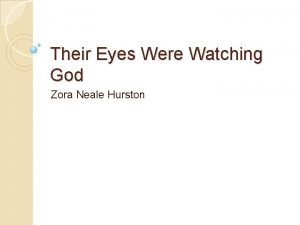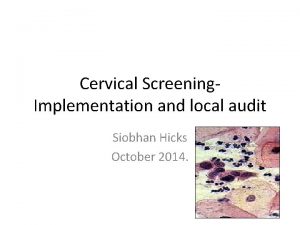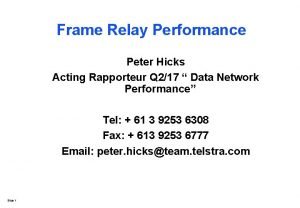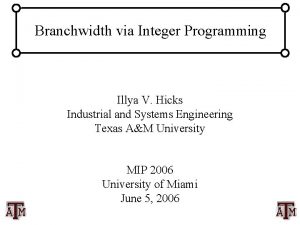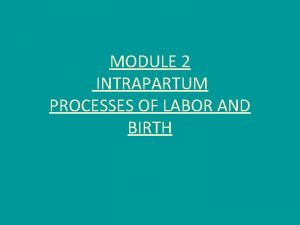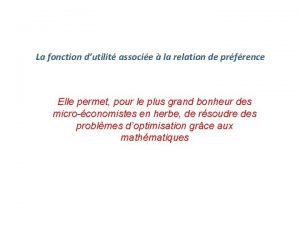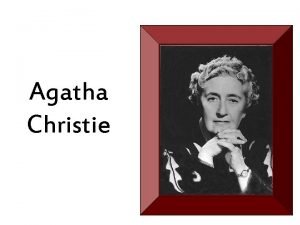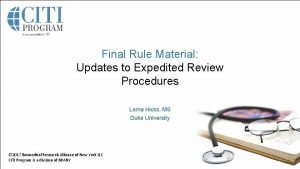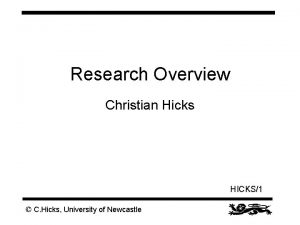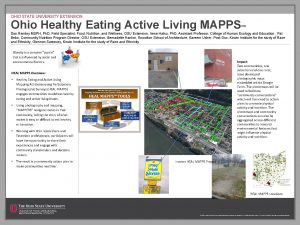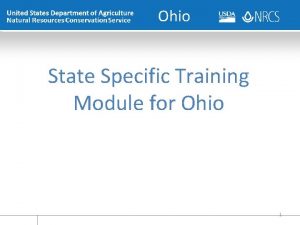K photoproduction from g 11 K Hicks Ohio
























- Slides: 24

K* photoproduction from g 11 K. Hicks Ohio University HSG meeting, 12 June 2009

OUTLINE • Review of K* photoproduction data • Theoretical interest • Presentations of preliminary analysis (Ohio students).

CLAS data (2007) I. Hleiqawi et al. , Phys. Rev. C 76 (2007) 039905 E.

New Data

Comparison Red (open) = CLAS, Black (solid) = TAPS Note the strong forward-peaking of TAPS data at higher photon energies.

K*+L (CLAS preliminary) L. Guo and D. Weygand, N* 2005 Conf. , hep-ex/060101. K*+ L shown by the RED points, quoted with 20% uncertainty.

Theory calculations: K*0 S+ Y. Oh and H. Kim, hep-ph/0605105. Model I (blue): no kappa form factor; Model II (red): with kappa form factor.

Theory comparison: K*+L Y. Oh and H. Kim, PRC 73: 065202 (2006). Full calculation (solid line) K+ t-channel only (dashed) Regge model (kaon trajectory)

Theory: a) K*+L , b) K*0 S+ Y. Oh and H. Kim, hep-ph/0605105. SOLID BLUE: no kappa form factor; DASHED RED: with kappa form factor

New: K*+ Photoproduction • • • Analysis by Wei Tang (Ohio grad student) Using g 11 data set Detecting: p+p- pair plus another p+. Missing mass of Lambda and Sigma Acceptance using fsgen + GSIM Absolute normalization (new) – Checked using K+ photoproduction.

Details on data and cuts • • Runs 43526 – 44107 used (E=4. 02 Ge. V). Bad paddles were removed. Photon identified using 1. 0 ns time cuts. Particle ID from SC and tagger time cuts. Standard fiducial and vertex cuts applied. Sideband subtraction to isolate K 0 events. K*+ mass cut from 0. 80 -0. 98 Ge. V.

Details on Normalization • Used gflux method to get photons. • Applied “trigger efficiency” map. – Mike Williams supplied this method. • Applied “dead time” correction. – INFN’s “current dependent correction” (18%) • No additional correction for start counter. – Lambda decay products not needed to fire the trigger (a la Mike Mc. Cracken).

K 0 mass peak

K*+ Mass Left s. b. Right s. b. K 0 peak minus sidebands

K*+ Missing Mass K*+ peak minus Sidebands.

MM: one kinematic bin Eg=1. 6 -1. 7 Ge. V and -1 < cosq < -. 078

MM: higher-E bin Eg = 2. 3 -2. 4 Ge. V and -0. 11 < cosq < 0. 11

Sample fit using gaussians

gp K*+L Cross Sections Units: mb Eg (Ge. V) W (Ge. V)

Check: K 0 S+ cross sections

Previous K 0 S+ data Eg = 1. 65 Ge. V SAPHIR data (not shown) also published. B. Carnahan, Ph. D, Catholic U. (pub. in Sarantsev et al. , Eur. Phys. J. A 25, 411 (2005).

Status of K*+ analysis • Preliminary differential cross sections OK. • Next step: systematic studies. • Just started: Lambda decay asymmetry – Statistics reduced by about ¼. • Plan: – Finish cross sections (1 month) – Preliminary Lambda asymmetries (1 month) – Write analysis note by end of summer.

Status of K*0 S+ analysis • This analysis is at a similar stage. – Normalization check requires more work • This is a “redo” of the published data. – I. Hleiqawi et al. (CLAS publication). • Overlap with nucleon resonances – Final state requires a PWA-like analysis. – This procedure was done for Hleiqawi data, but now we have good statistics!

Summary • K*0 and K*+ final states are nearly final. – Normalization issues took a lot of time. – Good agreement with previous data, but much higher precision. – For K*+, can also do L asymmetry. • Plan to have analysis note by the end of the summer. – This will be part of the Ph. D thesis of W. Tang.
 The own-wage elasticity of demand measures
The own-wage elasticity of demand measures Max mallowan jeune
Max mallowan jeune Well being abraham hicks
Well being abraham hicks Pittura vittoriana
Pittura vittoriana Marshallian hicksian slutsky demand curves
Marshallian hicksian slutsky demand curves Why does joe think that janie is being ungrateful?
Why does joe think that janie is being ungrateful? Efeito renda e efeito substituição
Efeito renda e efeito substituição Siobhan hicks
Siobhan hicks Peter hicks actor
Peter hicks actor Illya hicks
Illya hicks Tocodynamometer
Tocodynamometer équilibre du consommateur
équilibre du consommateur Hicks bargaining model
Hicks bargaining model Christie
Christie Christian hicks
Christian hicks Lorna hicks duke
Lorna hicks duke Michael hicks newcastle
Michael hicks newcastle Fema
Fema Uterine irritability vs braxton hicks
Uterine irritability vs braxton hicks Ohio revised code 3319
Ohio revised code 3319 Ohio state university lymphedema clinic
Ohio state university lymphedema clinic Oip training
Oip training Ohio technology standards
Ohio technology standards Preschool to prison pipeline
Preschool to prison pipeline Weight watchers meetings columbus ohio
Weight watchers meetings columbus ohio





